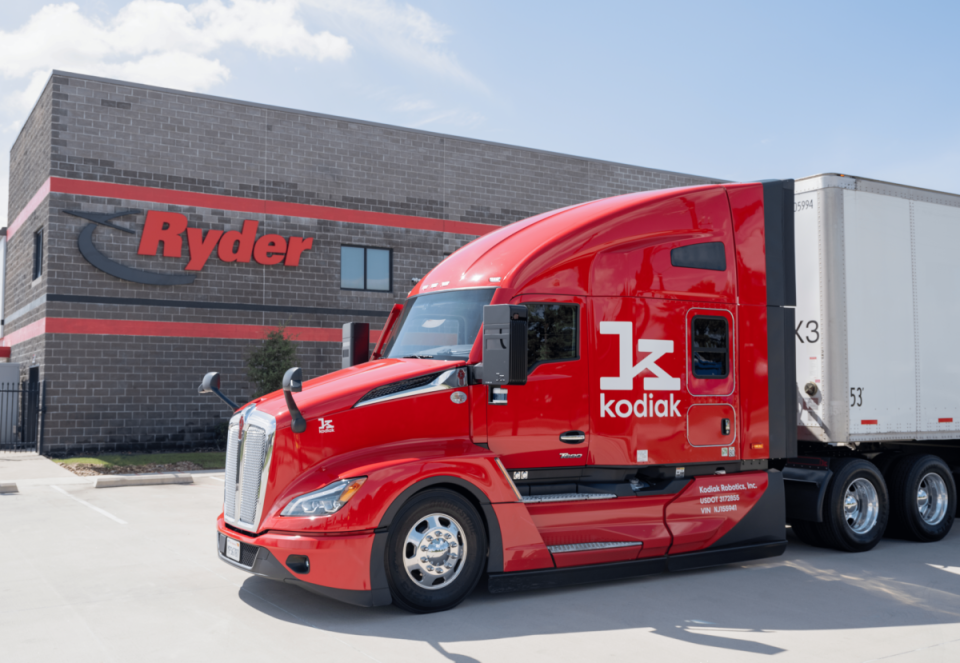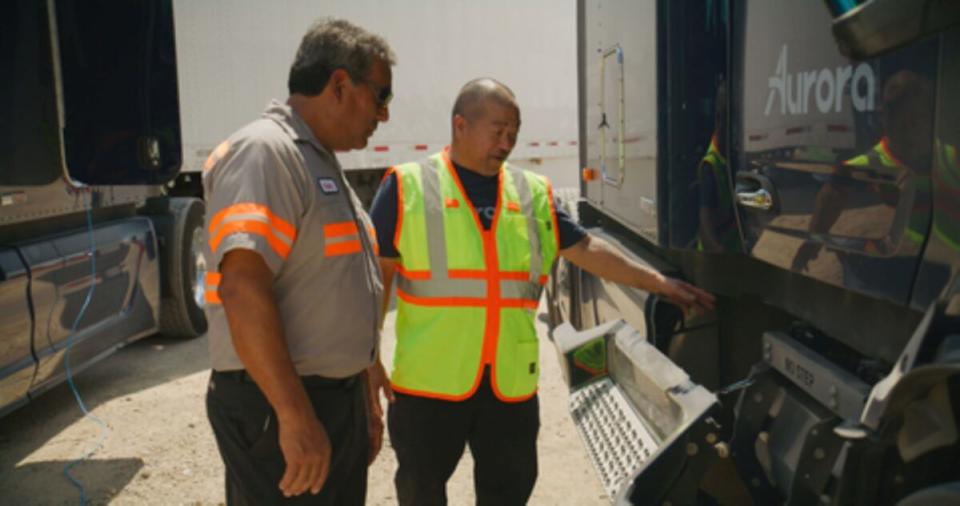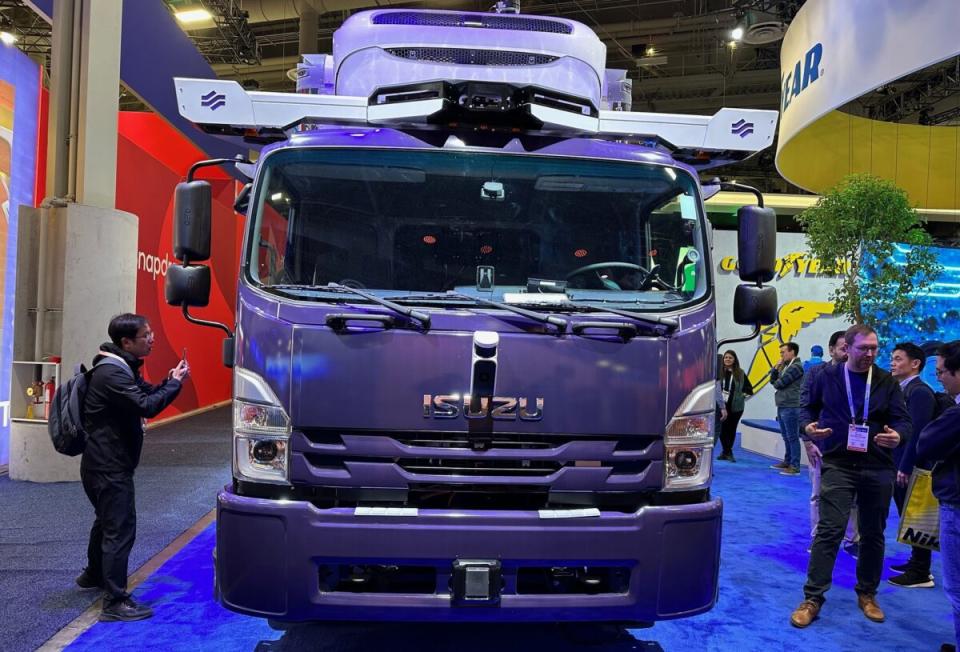Ryder adds Kodiak Robotics to its autonomous trucking dance card

When it comes to autonomous trucks, Ryder System Inc. plays the field, forming — and sometimes ending — relationships with practically every startup contending for leadership in the medium- and heavy-duty driverless space.
Its first commercial partner appears to be Kodiak Robotics, which is paying for space at an existing Ryder maintenance facility in Houston. The truckport opened in December and enables Kodiak to launch and land autonomous trucks and transfer freight on routes between Houston, Dallas and Oklahoma City.
The facility will be the starting point for driverless Class Kenworth T680s when Kodiak launches operations on its Dallas-Houston route along Interstate 45 later this year. The Mountain View, California-based company today operates routes with safety drivers, including its Houston-Dallas and Houston-Oklahoma City routes.

An ‘ideal partner’
“Ryder’s industry-leading fleet services and vast footprint of service locations makes it an ideal
partner as we scale autonomous trucks,” Don Burnette, founder and CEO of Kodiak, said in a news release. “Expanding our network of truckports with Ryder will enable us to operate autonomous trucks at scale with our customers.”
Kodiak also works on truckports with the Pilot Co. The two opened a launch-and-landing facility for autonomous trucks in May in Villa Rica, Georgia, 33 miles west of Atlanta near Interstate 20. It is Kodiak’s hub for East Coast operations.
“Kodiak’s relationship with Pilot is unaffected by the collaboration with Ryder,” Burnette told FreightWaves. “Pilot is an investor in Kodiak and is on Kodiak’s board of directors. Kodiak’s capital-efficient truckport strategy is to partner with industry leaders to leverage third-party infrastructure, rather than building company-owned facilities.”
Ryder applauds Kodiak’s approach.
“It keeps them from having to invest in real estate, which is smart on their part,” Karen Jones, Ryder executive vice president, chief marketing officer and head of new product development, told FreightWaves.
Revolving door of autonomous startup partners
Miami-based Ryder invests in Class 3-7 middle-mile autonomous startup Gatik. Ryder’s Class 8 experience amounts to a revolving door of startups.
It started in 2021 with TuSimple, at the time a leader in high-autonomy Level 4 trucking. TuSimple has shuttered U.S. operations to focus on Asia, specifically China, Japan and Australia. Waymo Via suspended most of its autonomous trucking efforts last year amid parent Alphabet Inc.’s cost cutting. Embark Trucks ran out of money before launching.
“We went to the party with a few. But that was really kind of our strategy from the very beginning,” Jones said. “It’s very important to us to make sure that we’re playing with the players that we think are going to actually have a chance at being the winners here.
“As new technology comes up, there are a lot of people that rush to it pretty quickly. I think that happened with autonomous trucking, and it’s a big expensive proposition. You’ve got to raise a lot of capital and have a lot of endurance to stay the course.”
Allowing access to its facilities, training technicians on aspects of autonomous trucks — as it has with Aurora Innovation — gives Ryder an inside look at the state of a technology that could revolutionize trucking.
If safety cases prove out, robot-driven trucks exempt from hours of service regulations could run 20-24 hours a day. Fleets could see 40% savings by removing the driver in hub-to-hub operations.
“The field is starting to sort of weed itself out,” Jones said. “But I think we’re still a long way off from knowing who the ultimate winners will be.”

Autonomous leadership hierarchy
Aurora, Kodiak and Torc Robotics, an independent subsidiary of market leader Daimler Truck, appear to lead the race, a hierarchy Jones accepts.
“All three have developed some pretty solid technology,” she said. “The big challenge for all of them now is the operational side of executing these lanes and learning how to launch and load freight. They’re all running to get the driver out, which is the ultimate goal of autonomous trucking. All three are very strong contenders.”
Jones’ biggest surprise in autonomous trucking has been Gatik, whose emphasis on shorter, repeatable middle-mile routes, has allowed the company to pull human drivers sooner.
“It’s really paid off for them to have that focus,” she said. “The cost of the equipment, the operational execution probably adds greater benefits than trying to do the long haul.”
And Gatik’s lack of competitors?
“I’m surprised they haven’t had a lot of competition. But at the end of the day, it’s a very expensive proposition to get into this game. It’s not for the faint of heart, that’s for sure.”

Ryder considers its own autonomous fleet
It’s nothing imminent, but don’t be surprised to see Ryder create its own autonomous trucking fleet. It has 760 maintenance facilities, more than a few of which could support driverless trucks.
“We have a number of areas that we can play in from being a carrier ourselves. We have a dedicated operation” Jones said. “If we put autonomous trucks into our dedicated fleet, what would that look like?”
It might resemble what Ryder is doing with Kodiak. That’s basic maintenance for now. But it could train technicians to work on autonomous hardware and software. Kodiak’s SensorPods, for example, contain all of the Kodiak Driver’s cameras, radars and lidars. They weigh about 45 pounds and can be swapped like replacing tires in a race track pitstop.
“We have not entered into that yet in our relationship of maintaining their specific technology,” Jones said. ”There’s a level of training that they want to ensure that we have and they have to impart to us to be able to do that type of thing.”
Related articles:
Kodiak reveals production-ready autonomous truck at CES
Aurora opens driverless trucking route in Texas admit autonomous jitters
Landing and launching terminals for autonomous trucks getting closer
Click for more FreightWaves articles by Alan Adler.
The post Ryder adds Kodiak Robotics to its autonomous trucking dance card appeared first on FreightWaves.
